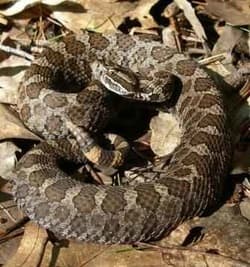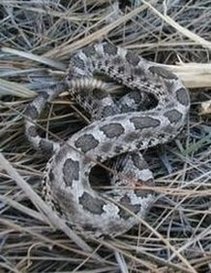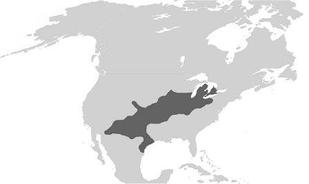Massasauga rattlesnakeSistrurus catenatus |

Custom Search
|
|
The massasauga rattlesnake (Sistrurus catenatus) is a small venomous pitviper species found in several states of the United States, southern Ontario in Canada and in northern Mexico on the border with Texas. There are 3 subspecies currently recognized by scientists.
The species can be found a variety of habitats in different regions ranging from sphagnum bogs, fens, swamps, wet meadows, open savannas, prairies and marshes to grasslands and floodplains. They are usually only found below 1500 m elevation. The adult massasauga rattlesnakes are small especially when compared with their largest cousin the eastern diamondback, they usually range from 24 to 30 inches (60 to 75 cm) in length. Their color pattern usually consists of a tan or gray ground color with a row of large rounded black or brownish blotches or spots down the middle of the back. They also have 3 smaller rows of alternating spots on each side, although sometimes the back blotches fuse with those on found on the sides. The juvenile massasauga pattern is more distinct but they are usually paler than the adult snakes. They have keeled scales and a single anal scale. Cases of solid black melanistic specimens are also known. They are sometimes confused with other rattlesnake species such as the timber rattlesnake. Just like all other rattlesnake species, massasaugas are pit vipers and have 2 heat-sensitive pits located between its eyes and nostrils.
They use these heat-sensitive pits, to track and locate prey, combined with their camouflage and venom makes them very effective predators. The massasauga rattlesnake lifespan in the wild is unknown but the species is known to live in captivity for 20 years. The word “massasauga” in Ojibwa (Chippewa language) translates to “great river mouth” and probably is a reference to the grasslands surrounding the river deltas in found in Chippewa territory. The species is also known by many other common names depending on the region like Michigan point rattler, massasauga rattler in Ontario little gray rattlesnake in Canada, the gray rattlesnake in Iowa or víbora de cascabel in Mexico. Other common names are black massasauga, black rattler, black snapper, dwarf prairie rattlesnake, eastern massasauga great adder, ground rattlesnake, muck rattler, prairie rattlesnake, spotted rattler, swamp rattler, Kirtland's rattlesnake, little black rattlesnake, prairie massasauga, small prairie rattlesnake, swamp massasauga, swamp rattlesnake, and triple-spotted rattlesnake. Subspecies / Taxonomy
There are 3 subspecies currently recognized by scientists. Desert massasauga (Sistrurus catenatus edwardsii - Baird & Girard, 1853) - Found mainly in the United States with some isolated populations in Mexico's northeast regions bordering Texas. In the USA the species is found in central and southern New Mexico, extreme southeastern Arizona and western Texas and on several barrier islands like San José Island, Matagorda Island and North Padre Island. Eastern massasauga (Sistrurus catenatus catenatus - Rafinesque, 1818) - Found in the United States and Canada. In the US can be found in eastern Iowa, northern Indiana, central/western New York, western Pennsylvania, northern and central Ohio, lower regions of Michigan, Illinois, southern and southwestern Wisconsin, northeastern Missouri and the extreme southeastern Minnesota, In Canada is found in along the shores of Georgian Bay in southern Ontario and Lakes Huron and Erie. Western massasauga (Sistrurus catenatus tergeminus - Say, 1823) - Found only in the United States northwestern Missouri, east-central Kansas, extreme southeastern Nebraska, west-central Oklahoma and northern and central regions of Texas down to the Colorado River. Venom / Bite The massasauga rattlesnake has a potent venom, but similar to their small size they have relatively short fangs. In the case of a bite most often they can't penetrate clothing and also deliver small amounts of venom. Most rattlesnake bites occur when people are attempting to hurt or handle them. There are only 2 recorded incidents of people dying from massasauga rattlesnake, and in both cases, they didn't receive proper medical treatment. The massasauga rattlesnake venom contains very specialized digestive enzymes that disrupt blood flow and prevent the from blood clotting. This causes severe internal bleeding and ultimately the death of the small animals they eat. Diet / Feeding
The massasauga rattlesnake diet includes mainly small mammals like mice, voles, and shrews although sometimes they also feed on other snakes, lizards, frogs, birds and bird eggs. When they are younger and smaller they feed mainly on insects such as centipedes. The juvenile massasauga rattlesnakes twitch their tail tips attracting frogs and toads into striking distance, this is known as caudal luring. They are ambush predators and usually strike and release their prey, waiting for them to die before eating them, but can also kill and eat smaller and less dangerous prey without using venom. Reproduction The massasauga rattlesnake breeds in the spring, the females give birth in late the summer. Rather than laying eggs as some snake species do, the female massasauga holds the babies inside their body for a period of about 3.5 months and the give birth to live young. Females lay their eggs under fallen logs or abandoned mammal burrows. The young snakes remain near their mother for just a few days after birth and then disperse. Massasauga rattlesnakes become sexually mature and capable of breeding at 3 to 4 years of age. Conservation / Threats The massasauga rattlesnake is classified as least concern species on the IUCN Red List, but the population trend is unknown. The species is already listed as endangered in Missouri, Ohio, Wisconsin, Pennsylvania, New York, Iowa, and Indiana and considered as "special concern" in Michigan, and may soon be declared endangered in Illinois. Under Ontario's Endangered Species Act the eastern massasauga rattlesnake is listed as a threatened species. In Minnesota, they are considered "Endangered" and are likely extirpated. The species has experienced a rapid decline since the mid-1970's, largely due to habitat loss and fragmentation.
|
Scientific classification |
© 2014 Snake Facts About Us | Privacy Policy | Contact









